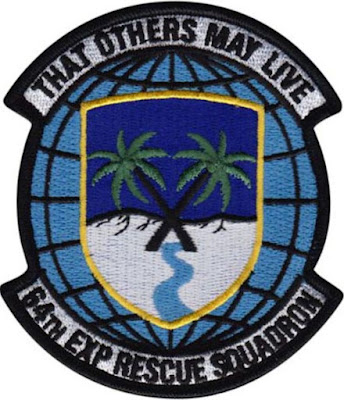The 64th ERQS has a complex history with classified aspects, leading back to the 8th Emergency Rescue Squadron. This unit became the 8th Rescue Squadron and eventually the 8th Air Rescue Group, featuring four flights: A through D. D Flight was later redesignated as the 64th Air Rescue Squadron. There are gaps and overlaps in the historical timeline due to classified information.
First
Helicopter CSAR
The 8th Emergency Rescue Squadron was activated on March 14, 1945, at Chanute AFB. Subsequently, it was deployed to China in May 1945, equipped with R-6 helicopters and supported by C-47 search aircraft.
Crews assemble the rotors onto a R-6 Hoverfly after it was delivered to theatre by C-47.
The Sikorsky R-8 Hoverfly was developed to improve on the successful Sikorsky R-4. In order to enhance the performance, a completely new streamlined fuselage was designed & the boom carrying the tail rotor was lengthened & straightened. It had a pilot plus room for an observer & would cruise at 75 mph for a maximum range of 115 miles with its 240 hp Franklin engine.
Designed for land rescue, the 8th ERS completed 43 saves in difficult, mountainous terrain that more than proved the value of the vertical lift R-6s. The 8th ERS were the first USAF Squadron to use helicopters in the CSAR role.
This amazing footage shows the R-6's from the 8th ERS in China.
Nuclear Armageddon
The 8th Emergency Rescue Squadron was activated on October 21, 1950, and initially assigned to the 3904th Composite Wing (SAC) at Camp Carson, Colorado. Around that time, it underwent a redesignation from ERS to the 8th Air Rescue Squadron. The 3904th was responsible for training SAC crews in rescue techniques, while the 8th focused on recovering aircrews, extending their missions to the polar region for targets in Russia and the Pacific for targets in China.
Due to the long-range nature of these missions, helicopters were not as practical, leading the 8th to utilize SC-47 aircraft, some equipped with detachable skis for landing on snow and ice. The Air Rescue Service proposed that the mission of the 8th should fall under their control rather than SAC. Eventually, it was decided that the 8th Air Rescue Squadron would establish the 8th Air Rescue Group on September 1, 1954, continuing its mission of aircrew recovery for SAC in the polar region and the Pacific Ocean.
In early 1954, the 64th Air Rescue Squadron was constituted on April 8, having been redesignated from D Flight of the 8th Air Rescue Group to which it was assigned. The squadron operated SA-16s and HH-19s, and it relocated to Norton AFB.
The Squadron played a role in Operation Hardtack, a series of 35 nuclear tests conducted at the Eniwetok Proving Ground in the Marshall Islands. These tests took place from October 21, 1957, to August 13, 1958.
This was the eighth explosion performed during the Hardtack tests & was named nutmeg. It was detonate on the 21 May 1958 at Bikini atoll & was a 21kt thermonuclear bomb.
It
moved to Bergstrom AFB, on August 21, 1959 before deactivating on June 18, 1960.
This is an early 64th Air Rescue Squadron patch from the 1950's.
War on Terror
The Squadron remained inactive for the following 43 years until it was redesignated as the 64th Expeditionary Rescue Squadron and activated in 2003, operating HH-60Gs. It was assigned to the 332d Expeditionary Operations Group and based at Balad AB, Iraq.
A patch made while the Squadron was based in Afghanistan.
During its time at Balad, the Squadron expanded from 3 Pavehawks to eight, and its crew of pilots, CROs, and PJs increased from 5 crews to 12 crews. This growth made the Squadron the largest combat search and rescue unit since the Vietnam conflict. With added aircraft and crews, they provided combat search and rescue support to Special Operations Command Central, playing a significant role in combat operations while maintaining their primary capability. The squadron operated on high-alert status, providing coverage 24/7 with enough crews to manage day and night shifts without disrupting rest schedules.
A crew patch made for a deployment to the 64th. Made in 2009 for Operation IRAQI FREEDOM & was in reference to the film anchor man.
The 64th Expeditionary Rescue Squadron underwent several reassignments during its active period, being reassigned to the 451st Expeditionary Operations Group in February 2009 and then to the 651st Air Expeditionary Group on June 29, 2011. Although there are anecdotal reports of the squadron moving from Balad AB to Taji AB in Iraq and later to Ali Al Salem in Kuwait, official documentation confirming these moves is not readily available.
It was officially reported that the 41st RQS was the last unit deployed with the 64th, conducting joint exercises with the U.S Army and Navy from May 29, 2012, to July 13, 2012. During this period, they accumulated a total of 145.7 hours and 1,263 total flying hours, including training events. The squadron engaged in various operations, such as terminal area employment with U.S Army AH-64 Apaches and shipboard operations with the U.S Navy.
The 64th Expeditionary Rescue Squadron was ultimately inactivated on December 31, 2013.
The 64th Expeditionary Rescue Squadron experienced a reactivation on September 1, 2015. This time, it was assigned to the 1st Expeditionary Rescue Group and operated from an undisclosed location in Southwest Asia. The squadron transitioned to flying HC-130s and played a crucial role in providing combat Search and Rescue (SAR) and support to coalition forces in the Iraqi theatre of operations, supporting both Operation IRAQI FREEDOM and NEW DAWN. Additionally, the squadron was tasked with conducting fixed-wing personnel recovery missions in support of Operation INHERENT RESOLVE.
Crews in desert flight suits prepare to fly a mission.
(USAF Photo)
If you have any additional information about this patch please contact me & I´ll get back to you.
Thanks👣
Thanks👣






No comments:
Post a Comment